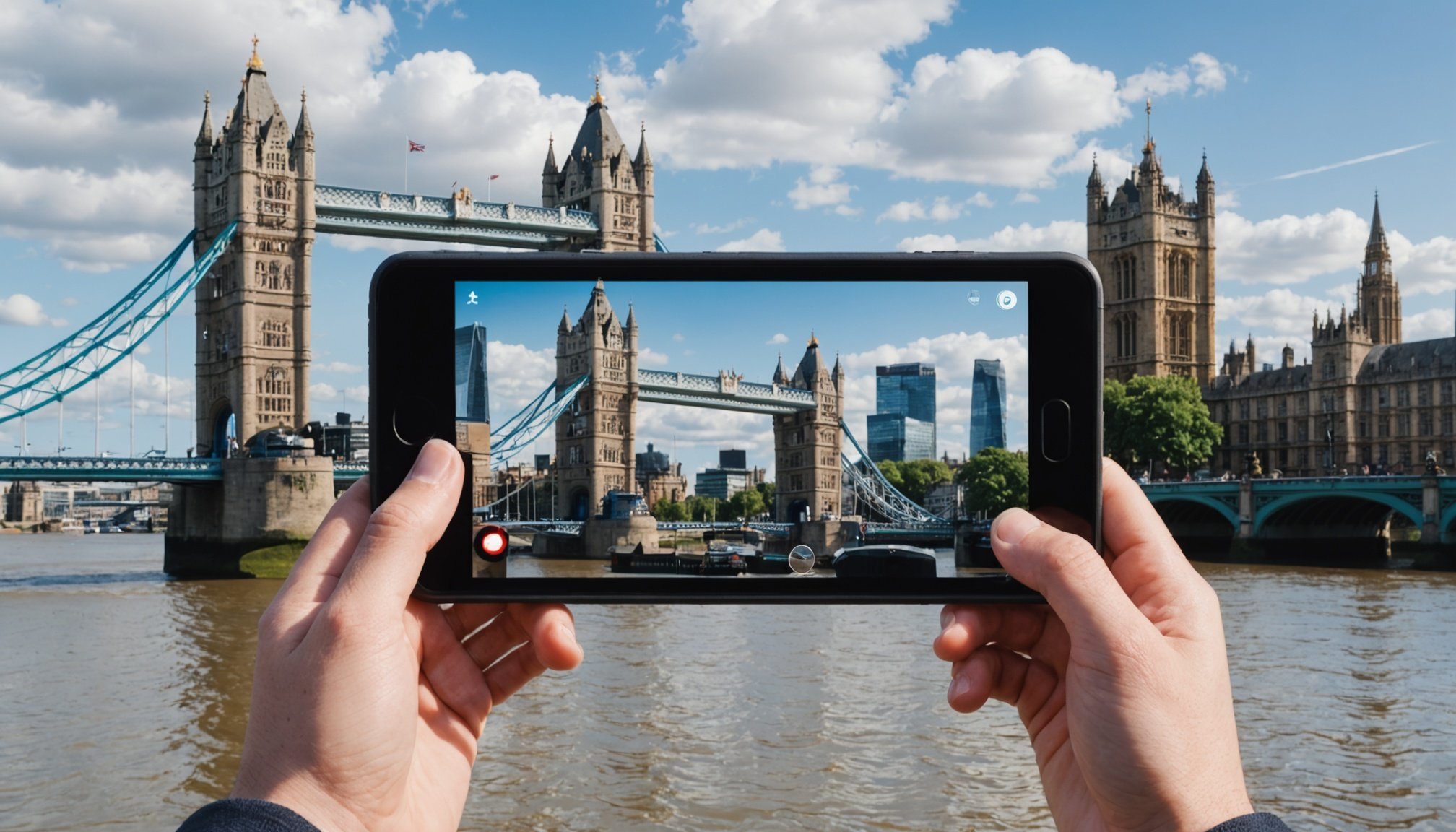Overview of Augmented Reality in Tourism
Augmented reality (AR) is reshaping the tourism industry by overlaying digital information onto the physical world, thus enhancing on-site experiences. Tourism technology, like AR, allows visitors to engage with attractions in novel ways, creating immersive environments where historical and cultural stories are brought to life. Interactive layers can be applied through apps or AR glasses, transforming mundane tours into unforgettable adventures.
In recent years, the adoption of augmented reality in UK attractions has witnessed a significant rise. Studies reveal that approximately 45% of tourist venues have integrated AR into their exhibitions and services. This trend underscores the increasing visitor engagement driven by augmented experiences, as tourists are more likely to visit sites offering tech-savvy enhancements.
Also read : Top data privacy tactics for uk smes in global transactions: key strategies for protection
Demographics of visitors indicate a substantial interest in technology-enhanced experiences across various age groups. Millennials and Gen Z visitors, who are more inclined towards technological innovations, form a large part of this audience. However, interest in AR is not limited to younger generations; older tourists are also showing curiosity and willingness to explore these interactive offerings. By fostering engagement through augmented reality, the tourism sector can meet evolving visitor expectations, offering rich, dynamic, and personalized adventures.
Case Studies of AR Integration in UK Tourist Attractions
In today’s tech-savvy world, UK tourist attractions are embracing augmented reality (AR) to enhance visitor experiences, providing new ways for guests to engage with history and culture.
In the same genre : Revolutionizing credential verification: how uk universities can leverage blockchain technology
The British Museum: Enhancing Historical Context
The British Museum offers compelling augmented reality examples that have transformed how visitors explore historical contexts. The museum’s AR app allows users to interact with artefacts digitally, providing educational benefits by bringing exhibits to life. Feedback indicates the app significantly improved visitor engagement, with user satisfaction ratings soaring post-implementation. Following this innovation, the museum observed a notable uptick in visitor numbers, showcasing the appeal of technologically-enhanced tours.
Cadbury World: Interactive Experiences with AR
Cadbury World redefines interactive experiences through AR features, which engage visitors of all ages. This includes virtual chocolate-making workshops and engaging narratives that elevate the traditional tour experience. Such innovations have notably boosted family visits and promoted group interaction. When compared to traditional tours, AR-enhanced visits have seen increased participation, making them highly appealing for audiences seeking immersive experiences.
The Tower of London: Immersive Historical Experiences
At the Tower of London, AR offers immersive historical reconstructions, allowing visitors to witness key events from British history first-hand. Survey feedback demonstrates high satisfaction rates, while experts affirm AR’s crucial role in modern historical education. Such integration is reshaping how historical narratives are told, fostering a deeper connection with the past.
Benefits of Augmented Reality for Visitors
Augmented Reality (AR) offers visitors an enriched experience by significantly boosting visitor engagement. One of the key AR benefits lies in transforming passive observation into an active, interactive learning adventure. Visitors can explore layers of information seamlessly overlaid on their surroundings, unraveling stories and details they might have otherwise missed. This heightened level of interactivity captivates users, encouraging them to delve deeper into the content at hand.
The educational value provided by AR cannot be overstated. Through immersive experiences, visitors grasp complex topics more easily, fostering a deeper understanding of the sites they explore. For example, viewing lifelike 3D recreations of ancient artefacts can help visitors better comprehend historical contexts. Such engaging formats often lead to improved retention of information, transforming routine visits into remarkable learning journeys.
Moreover, AR strengthens tourists’ emotional connection to historical sites. By offering personalized narratives and interactive elements, AR enables visitors to relate more intimately with historical events and figures. This unique bonding enhances appreciation and often leads to a more meaningful and memorable experience. As visitors emotionally invest in the stories told, they are left with a lasting impression and a desire to share their experiences with others.
Technological Considerations for Implementing AR
The implementation of AR technology in UK attractions requires careful consideration of both hardware and software components. At the core, technology requirements include devices capable of supporting augmented reality applications, such as smartphones or dedicated AR glasses equipped with high-resolution displays and robust processing power. These devices must also be integrated with AR-specific software that facilitates an immersive and seamless experience for users.
Before embarking on the AR deployment journey, an evaluation of existing infrastructure is paramount. This assessment should determine if networks, such as WiFi and mobile data, can support the high bandwidth demands of AR applications. It’s critical to ensure that the technological framework is robust enough for the added stress that augmented reality will place on it, without compromising user experience.
Implementation challenges often arise during the initial deployment phase. These can include compatibility issues with older hardware, limitations of current infrastructure, and the need for frequent updates to both software and hardware to guarantee smooth AR functionality. Maintenance is another hurdle, necessitating regular checks and updates to safeguard against technical hiccups.
By effectively addressing the technology requirements and overcoming these challenges, UK attractions can leverage AR technology to enhance visitor engagement and create captivating, interactive experiences.
Accessibility of AR Experiences for Diverse Audiences
Creating accessible augmented reality (AR) experiences is essential in ensuring that tourists from various backgrounds can engage meaningfully. AR technology has the potential to make tourism more inclusive, benefiting visitor demographics that might otherwise face barriers. However, there are noticeable technology gaps that need addressing for differently-abled visitors.
For differently-abled individuals, it’s essential to offer AR solutions accommodating various needs. This could include voice commands, text-to-speech features, or haptic feedback systems. Ensuring that these features are a fundamental part of AR platforms can empower users and close the technology gap.
Moreover, AR experiences should be customized to cater to different age groups, making them engaging for both young children and older adults. A well-crafted interface, for example, might offer simpler navigation for younger users and advanced settings for tech-savvy adults, enhancing their overall experience.
Strategies for broadening accessibility include designing inclusive apps that adhere to universal design principles, which consider the widest possible range of users from the start. Another approach is to consult with demographic experts to understand specific needs and tailor AR experiences accordingly.
Ultimately, to ensure that all visitors benefit from AR enhancements, continuous feedback loops with diverse users are vital, allowing developers to refine and adapt experiences to various requirements.
Expert Insights on Future Trends in AR for Tourism
With the advent of augmented reality (AR) technologies, the tourism industry is witnessing a transformative phase. Industry leaders and technology experts are predicting significant future trends that will shape tourist attractions. One of the key projections involves the integration of AR with artificial intelligence (AI) to enhance user experiences. This synergy enables personalised tours and real-time translations, making visits more engaging and accessible.
Predictions for AR Development in Tourist Attractions
Experts believe AR innovations will revolutionise how visitors interact with landmarks. User feedback is crucial in shaping these advancements, ensuring that new features are in line with tourist needs. This iterative development process is expected to lead to:
- Improved user interfaces for seamless navigation
- Interactive storytelling with dynamic visualisations
- Enhanced accessibility features, such as audio descriptions for visually impaired tourists
The Intersection of AR and Other Technologies
The intersection of AR with virtual reality (VR) and AI promises to open new vistas in tourism. This convergence is yielding new business models, including collaborative experiences where tourists can engage with digital avatars or participate in virtual explorations. By leveraging these innovations, the industry can offer unique, immersive experiences that go beyond traditional sightseeing. Such prospects not only enrich the tourist experience but also provide opportunities for creative partnerships among tech firms and travel operators.
Potential Drawbacks of Augmented Reality in Tourism
While augmented reality (AR) offers promising enhancements, it also presents several drawbacks in tourism. One of the primary AR drawbacks is the technology’s current limitations and accessibility issues. Not all tourists possess the necessary devices or internet connectivity, which limits the reach and effectiveness of AR. Moreover, technical glitches can disrupt the experience, leading to visitor challenges.
Another significant concern is the possible negative impact on the authenticity of tourist experiences. AR can sometimes overshadow the genuine atmosphere of a location, leading tourists to focus more on digital overlays than the actual environment. This shift may diminish the historical or cultural value of sites, raising tourism concerns.
Data privacy and visitor tracking also raise valid issues. AR applications often require access to location data, posing potential risks related to personal information misuse. Tourists might be uncomfortable with constant tracking, creating a barrier to AR acceptance.
- Limitations in user devices and network access
- Challenges in maintaining experiential authenticity
- Privacy concerns regarding data collection and tracking
Understanding these tourism concerns is vital in addressing and mitigating the challenges AR presents, ensuring the technology enhances rather than detracts from the travel experience.











